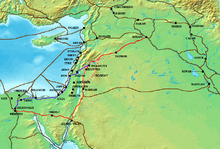Via Maris
This articleneeds additional citations forverification.(November 2013) |


Via Marisis one modern name for an ancienttrade route,dating from the earlyBronze Age,linkingEgyptwith the northern empires ofSyria,AnatoliaandMesopotamia– along the Mediterranean coast of modern-dayEgypt,Israel,TurkeyandSyria.InLatin,Via Marismeans "way of the sea", a translation of the Greek ὁδὸν θαλάσσης found inIsaiah 9:1of theSeptuagint,itself a translation of the Hebrew דֶּ֤רֶךְ הַיָּם֙ . It is a historic road that runs in part along the Palestinian Mediterranean coast. It was the most important route from Egypt to Syria (theFertile Crescent) which followed the coastal plain before crossing over into the plain of Jezreel and the Jordan valley.
One earlier name was "Way of thePhilistines",a reference to a passageway through the Philistine Plain (which today consists of Israel's southerncoastal plainand theGaza Strip). Academic researchers prefer other names, for instance "International Trunk Road"[1]or "International Coastal Highway"(also uncapitalised).[2]
Together with theKing's Highway,theVia Mariswas one of the major trade routes connectingEgyptand theLevantwithAnatoliaandMesopotamia.TheVia Mariswas crossed by other trading routes, so that one could travel from Africa to Europe or from Asia to Africa. It began inal-Qantaraand went east toPelusium,following the northern coast ofSinaithroughel-ArishandRafah.From there it followed the coast ofCanaanthroughGaza,Ascalon,Isdud,Aphekavoiding theYarkon River,andDorbefore turning east again throughMegiddoand theJezreel Valleyuntil it reachedTiberiason theSea of Galilee.Again turning northward along the lake shore, theVia Marispassed throughMigdal,Capernaum,andHazor.From Hazor it crossed the northernRiver Jordanat what later became known asJacob's Ford,then climbed sharply over theGolan Heightsand wound its way northeast intoDamascus.Here travellers could continue on the King's Highway as far as theEuphrates Riveror proceed northward into Anatolia.
Name and controversy
[edit]According toAnson Rainey(1981),[3] "Via Maris" is not the historical name of any road. The phrase rather originates as the Latin translation ofIsaiah 9:1(in theHebrew Bible,8:23) – "by the way of the sea".[4]The prophet was probably referring to the road fromDanto the sea atTyre,passing throughAbel-beth-maachah,[5]which marked the northern border ofIsraelat the time of the Assyrian conquest.
The road mentioned in the traditional description is better listed asthe Great Trunk Road.This Egypt-to-Damascus route is so designated byBarry J. BeitzelinThe New Moody Atlas of the Bible(2009), p. 85, by John D. Currid and David P. Barrett in theESV Bible Atlas(2010), p. 41, and by Rainey and Notley inCarta's New Century Handbook and Atlas of the Bible(2007), p. 76. Carl G. Rasmussen in theZondervanAtlas of the Bible(2010), p. 32, also notes the traditional misnomer and denotes the Egypt–Damascus route asthe International North-South Route.
Rasmussen, basically in agreement with Langfur and Rainey, suggests that theVia Mariswas the road that connectedTyrewithDamascus.Beitzel, in contrast, denotes the Via Maris as a road from Ptolemais (Acco /Acre) toKedesh(Kedesh-naphtali) in the Galilee – also leading west to east, but slightly further south and not reaching so far inland.
See also
[edit]Ancient routes
[edit]- Barid,Muslim postal network renewed during Mamluk period and connecting Cairo with Damascus
- King's Highway (ancient)– an alternative, more easterly ancient route between Egypt and Mesopotamia
- Salah al-Din Road– the main highway of the Gaza Strip, crossing the territory from north to south
- Way of the Patriarchs– the biblical north-to-south route through the mountains of Canaan
- Grand Trunk Road– one of Asia's oldest and longest major roads linking South Asia and Central Asia.
Sites along Via Maris
[edit]- Shimron,now Tel Shimron
References
[edit]- ^Northern Exposure: Launching Excavations at Tell Abil el-Qameḥ (Abel Beth Maacah),p. 32, in Strata: Bulletin of the Anglo-Israel Archaeological Society, 2013, Volume 31
- ^Barry J. Beitzel,Bible Lands: How to Draw Ancient Highways on Biblical Maps,Bible Review 4:5, October 1988
- ^Anson Rainey, "Toponomic Problems (cont.)" in Tel Aviv 8 (1981), cited after Stephen Langfur,The "Via Maris" (netours )Archived2015-09-15 at theWayback Machine,c.f. also Anson F. Rainey and R. Steven Notley'sCarta's New Century Handbook and Atlas of the Bible(2007), p. 76: "The coastal trunk route (popularly and wrongly calledVia Maris),... "
- ^Isaiah 9:1/Hebrew Bible Isaiah 8:23: "In the past he humbled the land of Zebulun and the land of Naphtali, but in the future he will honor Galilee of the Gentiles,by the way of the sea,along the Jordan. "TheVulgate(the Christian Bible, both the Old andNew Testamentin Latin translation),Matthew 4:15reads: "terra Zabulon et terra Nephthalimvia maristrans Iordanen Galilaeae gentium "–" The land ofZebulunand the land ofNaphtali,by the way of the sea,beyond theJordan,Galilee of the Gentiles. "(NKJVtranslation)
- ^Nava Panitz-Cohen et al.,Northern Exposure: Launching Excavations at Tell Abil el-Qameḥ (Abel Beth Maacah),p 32 in Strata: Bulletin of the Anglo-Israel Archaeological Society, 2013, Volume 31
